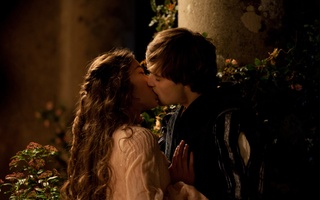William A. Grace ’12, the director of the Harvard-Radcliffe Dramatic Club production of “Romeo & Juliet,” does not lay his scene in gentle Verona; instead it is set in a playground. A rope bridge is stretched along the center of the stage. Ladders and stairs connect one platform to another. While the teenage Juliet (Rebecca E. Feinberg ’13) swings gleefully on one of two swings which dangle stage-right, her older suitor, Paris (Felix L. Cook ’13) sits with his back ramrod straight.
In this rendition of Shakespeare’s tragedy, which runs in the Loeb Experimental Theater from December 3-5 and again from December 8-11, Romeo and Juliet are shown for what they are: teenagers who are closer to childhood than adulthood and have more passion than they can handle. Juliet gets married in a white sundress and black Converse. Romeo (Philip M. Gillen ’13) ties a string around Juliet’s finger in place of a wedding band. Benvolio (Nasir W. Husain ’12) perpetually wears skinny jeans and his lover, Mercutio (Alexander P. Raymond ’12) plays the ukulele. The allusions to the hipster aesthetic, also present in Grace’s superb sound design, provide a compelling modern twist on the story.
Though occasionally style threatens to overwhelm substance, Grace’s production succeeds in depicting the naïveté of the lovers without undermining the depth of their passions. When the staging ties in with the themes of the performance, which is more often than not, the effect is dazzling. With each death, glaring, unforgiving white fluorescent lights are activated. Though Grace’s production may emphasize the youthful hope of the lovers, it does not sugarcoat the tragic consequences of their love. In a beautiful moment of juxtaposition, an ebullient Juliet waits on the balcony for her groom, as Romeo sits huddled in Friar Lawrence’s cell and Benvolio scrubs Mercutio’s blood from the floor.
The production is somewhat abridged, most notably leaving out the opening fight scene between the Capulets and the Montagues, which sets up the dynamic between the warring families. This abridgement leaves room for Grace to supplement the text with contemplative, silent scenes, which help establish the relationships between the characters. Nonethelss, this brevity comes at a cost. Without the first fight scene, the integral fight between Tybalt (Matthew J. DaSilva ’12) and Mercutio feels almost arbitrary. In many productions, Tybalt and Mercutio are vivid and over-the-top, energetic counterparts to the otherwise straight-laced cast of characters. Raymond’s Mercutio is woefully understated, failing to realize the mesmerizing effect of the notorious Queen Mab monologue. As for DaSilva’s Tybalt, he seems to die as quickly as he appears.
Fortunately, this does not significantly detract from the rest of the performance or from Raymond’s believable chemistry with Husain. Grace’s interpretation of Mercutio and Benvolio as gay lovers may at first seem like an arbitrary choice to enliven the story. However, it updates the classic in a believable fashion and the parallel between the two couples adds a novel dimension to the story. Reinterpreting Mercutio and Benvolio as lovers also changes the latter’s characterization. In most productions of “Romeo and Juliet”, Benvolio serves as the straight man to the lovelorn Romeo and the theatrical Mercutio, but Husain’s performance breaks from this tradition. After the death of Mercutio, Husain walks with a defeated slouch and one can hear true devastation in his voice, saying “Thy dear love sworn but hollow perjury, killing that love which thou hast vow'd to cherish.”
Gillen and Feinberg also exhibit powerful chemistry. Individually, though Gillen does a respectable job of portraying Romeo, Feinberg’s Juliet outshines him. Feinberg is able to depict Juliet’s innocence without compromising her devotion to Romeo. The result is a Juliet who plucks at the audience’s heartstrings with startling candor. After hearing of Romeo’s banishment, she sobs like a younger girl, her voice wavering. “'Romeo is banished!' There is no end, no limit, measure, bound, in that word's death; no words can that woe sound,” she utters between weeps.
The evocative choreography of Maria-Ilinca Radulian ’11, fight/movement/sex coordinator, should be noted. The delicate sway of the swings is incorporated in the movements of the lovers, adding an air of youthful whimsy to their romance. This is one of many tropes in Grace’s production that highlights what makes Romeo and Juliet a tale of woe: they are too young to handle the depth of their passions.
Read more in Arts
Dancing Flash Mob Brightens AnnenbergRecommended Articles
-
 'Gnomeo & Juliet' Colorful But Confused
'Gnomeo & Juliet' Colorful But Confused -
 Claire Danes Named Woman of the Year
Claire Danes Named Woman of the Year -
 Adapted "Romeo" Not So Sweet
Adapted "Romeo" Not So Sweet -
Women's Lacrosse Splits Weekend to Open SeasonThe Crimson suffered a 14-10 loss to Stanford on Saturday, but the team rallied back on Sunday to defeat St. Mary’s, 18-7, and end the weekend with an even slate.
-
Women's Lacrosse Defeats Cornell in Home OpenerReturning home after its first two games of the season in California, the Harvard women’s lacrosse team fought through in-game adversity to come out victorious in its home opener.
-
 Venn Diagram: Shakespeare vs. Shake Shack
Venn Diagram: Shakespeare vs. Shake Shack













